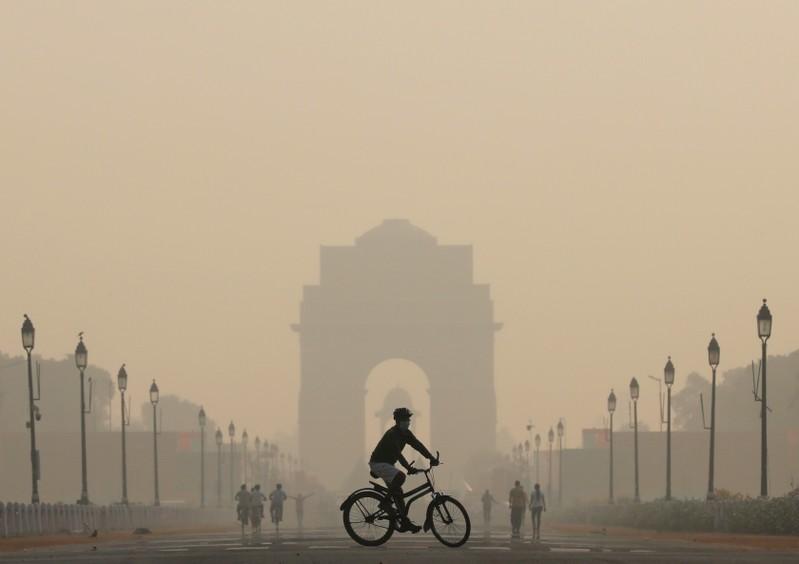Nature Is Not Healing: Pollution Remained A Problem In 2020
Dec 25, 2020 | Pratirodh Bureau
A man rides a bicycle on a smoggy morning near India Gate in New Delhi
Dolphins did not return to cleaner canals in Venice, Italy this year. Nor was the critically endangered Malabar civet spotted on the streets of Kerala, India. And, contrary to one meme, there definitely were no dinosaurs in Times Square. Most of the memes that claimed “nature is healing” while COVID-19 shut down business around the world were misleading or just a joke to lighten up a heavy year. The reality is, even if it managed to keep people holed up for parts of the year, the pandemic is not leaving us with a healthier planet.
There were fewer plane trips and car trips this year, which means fewer tailpipe emissions. But that didn’t result in huge environmental gains. If anything, this year actually showed us how much further we have to go to clean up the giant mess we’ve made on our planet.
For starters, assessing air quality in 2020 is complicated. As early as January, it seemed as if skies had cleared over China — the first country to cope with the novel coronavirus and its economic fallout. Nitrogen dioxide levels over China plummeted dramatically in maps released by NASA and ESA.
As the pandemic progressed, similar reports of cleaner skies emerged across the globe. In November, NASA figured out that the pandemic led to an almost 20 percent drop globally in nitrogen dioxide concentrations. Nitrogen dioxide is a toxic gas found in tailpipe emissions, so it makes sense that it dropped as people stayed home.
But that’s only part of the picture when it comes to air quality.
As nitrogen dioxide pollution fell, another dangerous type of pollution seemed to stagnate and even rise in some places in the US. Particulate matter pollution — made up mostly of soot from burning fuels — didn’t seem to let up during the peak of pandemic-induced stay-at-home orders in April, a recent study found. That’s especially dangerous during the pandemic because of how much damage particulate pollution can do to people’s lungs and hearts — organs that COVID-19 impairs, too.
The pandemic may not have made a significant dent in pollution, but pollution certainly made the pandemic worse for some hard-hit communities. Living with air pollution — especially particulate matter — is linked to an increased risk of dying from COVID-19, research found this year.
Black and Latino people, who are disproportionately burdened with air pollution in the US, also faced way higher hospitalization and death rates during the pandemic than white Americans.
Researchers have some ideas about why particulate pollution grew and nitrogen dioxide shrank in the US this year. It might be because more particulate matter comes from diesel-burning trucks, which delivered more packages than usual as people shopped from home, but they still need to test this hypothesis.
“That is the mystery that we’re going to try to solve,” says Cristina Archer, lead author of the study and a professor at the University of Delaware’s College of Earth, Ocean and Environment.
Even if some pollution dropped temporarily, that doesn’t really do us much good moving forward, Archer cautions. “We’re going to go back eventually to normal life,” she says.
Nitrogen dioxide levels already started roaring back toward the middle of the year in cities around the world as COVID-19 restrictions lightened up. “Reduction [in pollution] that is temporary, but is not actually intentional — I don’t think it helps much. What helps are strategies, and planning, and conscious efforts to reduce air pollution.”
The same goes for greenhouse gases. The US saw its biggest year-on-year drop in carbon dioxide emissions in 2020 as Americans stayed home to stop the spread of COVID-19. Worldwide emissions actually dropped to their lowest levels since 2006 in April.
By the end of the year, global CO2 emissions are projected to fall by about 7 percent. But to stop the world from careening toward catastrophic levels of climate change, we need to keep cutting more than 7 percent of our emissions each year over the next decade — without a pandemic forcing that change upon us. Without those intentional cuts, the overall amount of carbon dioxide in the atmosphere will continue to rise, as it did this year.
“Humanity’s waste pile is in the atmosphere and that doesn’t go away,” Ralph Keeling, a professor of geochemistry at Scripps Institution of Oceanography at the University of California, San Diego, told The Verge earlier this year. “The CO2 is building up in response to not just what we’re emitting right now but what we have emitted over the past century.”
Ultimately, this isn’t a numbers game. Once we’ve unleashed pollutants into our environment, they come back to haunt us. All that carbon dioxide heating up our planet is making summers hotter and fires more devastating.
Hotter weather boosts the chemical reaction that creates smog, which is one of the reasons why Southern California — one of the most polluted regions in the US — had worse smog this year than it had seen in decades.
Historic wildfires across the Western US in the second half of the year darkened skies. The smoke simultaneously made it harder to breathe and canceled out the reduction in greenhouse gas emissions from the US power sector this year.
As 2020 draws to a close, we’re still in the thick of the global health crisis caused by COVID-19.
Once that danger passes, however, pollution will still pose a threat to people’s health and the planet’s. That is, unless we heed the advice of scientists like Archer and make more conscious efforts to do something about it. If we really want to nurse nature back to health, we can’t rely on a pandemic to do it for us.
(courtesy: The Verge)
